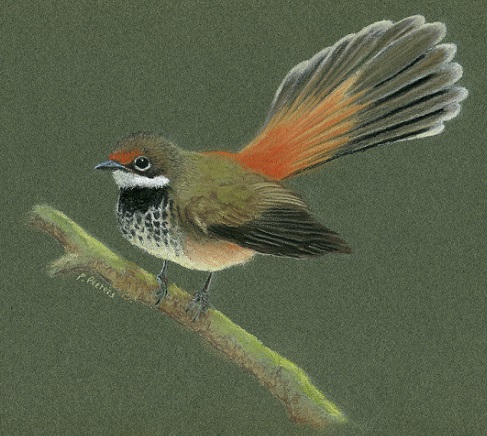Around Easter-time it starts. The stirring of retired folks – the ‘grey nomads’ – as they load up their 4WD’s and caravans and head north for the winter. In south-east Queensland you see them on the freeways, mostly up from the colder south. On their way, passing through. They may stop for a night or two, but are eager to be off, to the warmth and the sun of the ‘north’.
These human nomads may not realize that their peregrinations mirror those of many Australian birds who also travel north in autumn. And unlike their human counterparts, many of these birds – even some very small ones – keep going when they get to the end of the mainland. Something makes them fly out across the waters, and onward, over the Torres Strait, to finally spend winter in New Guinea, or further afield.
Last year, one of these birds arrived in our garden, on Easter Sunday, and spent 2 days here, on the northern outskirts of Brisbane. It was the little ‘red nomad’ – the delightful rufous fantail. With a hint of the sublime, and far better than chocolate eggs, this little visitor¹ brought much joy as it flitted and flirted near the pond.
The rufous fantail usually lives in wet eucalypt forest or rainforest, sometimes drier forests and woodlands, and also paperbark swamps and mangroves. We have a small suburban lot, in a street with sparse gardens, although eucalypt woodlands, paperbark swamps and mangroves grow nearby. Our garden is dominated by noisy miners who usually drive the smaller birds away. We’ve seen rufous fantails in the mangroves, but never in our garden. The Easter visitor spent its time in the thick native plants around our small backyard wetland, which seemed to provide the ideal habitat structure for its kind.²
Where was this bird from, and where was it going?
Two races of the rufous fantail are strongly migratory. Both are seen in south east Queensland in autumn, on their way to warmer climes. Rufifrons lives here in the summer, while intermedia spends its summer in Victoria and New South Wales (like many of the human grey nomads). So the little bird in our garden may have come from the nearby mountains or mangroves. Or it may have traveled from far away, perhaps from a misty ash forest in the highlands of Victoria.
Rufous fantails are fairly regular in the timing of their departure, and their return. Twenty-eight rufous fantails were seen in one day at Mts Nebo and Kembla in New South Wales. They have been observed traveling low over the water across Torres Strait. And 40 rufous fantails were seen in 3 hours on a single Torres Strait island. Some will keep going, to overwinter in southern New Guinea. If these birds talk to each other, what do they say? Do they swap notes on the wind, weather, and the quality of their accommodation? They may follow the same route each year. Do they stay in the same patches of forest, the same shady gullies, every year, along the way? What happens if a stopover place has been bulldozed by developers, or shredded by a recent cyclone?
Rufous fantails are known to live for as long as 9 years. We’re hoping that our stopover accommodation is still up to scratch, and it’s been noted in the travel diary of at least one red nomad. We’re looking out for the return of our Easter visitor this year, but will have chocolate eggs on hand, as a consolation for us, if the little bird doesn’t appear.
1. Rufous fantails are about 16 cm long, including tail.
2. Structural features of suitable rufous fantail habitats are moderately dense canopy-cover, often with two lower strata: a layer 2-6 m high, and a shrubby of heath understorey 1-2 m high.
Reference: Handbook of Australian, New Zealand and Antarctic Birds: Boatbills to starlings, Vol. 7.

